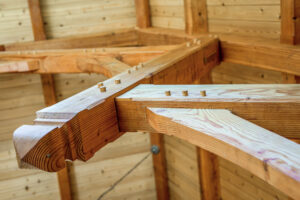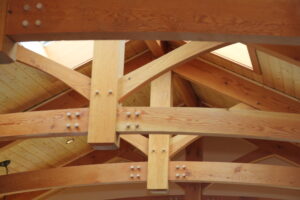The History and Progress of Pegs in Mortise and Tenon Joinery
When you look at a timber frame, one of its most iconic features is the wooden peg — simple, round, and often slightly proud of the beam’s surface. But that humble peg represents centuries of refinement in joinery, craftsmanship, and engineering. From early hand-hewn pegs to today’s precision-turned hardwood dowels, the story of the peg mirrors the evolution of timber framing itself.
Early Origins: The Wooden Nail
Before the advent of metal fasteners, woodworkers relied on wooden pins, or “treenails” (from the Old English trēow meaning “tree”), to secure timbers together. These early pegs were often hand-carved from dense hardwoods like oak, hickory, or locust — chosen for their toughness and ability to swell slightly within a joint, locking it tight.
In medieval Europe and early colonial America, these pegs were made individually by craftsmen using drawknives and shaving horses. Each was slightly irregular, but that was part of their function — as the peg was driven into an offset hole (“draw-bored”), it pulled the tenon snugly into the mortise, creating an incredibly tight fit without glue or metal.
Refinement Through the Ages
As timber framing became more standardized during the Renaissance and into the Industrial Revolution, so did the production of pegs. Craftsmen began to prefer round rather than square pegs for ease of driving and more consistent performance.
By the 18th and 19th centuries, specialized peg-making tools like dowel plates allowed builders to shave pegs to uniform diameters. This period also saw the development of intentional “green peg” use — driving slightly green pegs into seasoned timbers so they would expand as they dried, locking joints even tighter.
The Transition to Modern Times
 When metal fasteners became cheap and widely available, wooden pegs fell out of everyday construction use. But in the world of timber framing — where tradition, aesthetics, and structural performance all matter — pegs never disappeared. In fact, modern timber framers (including Timbercraft) have revived and perfected them.
When metal fasteners became cheap and widely available, wooden pegs fell out of everyday construction use. But in the world of timber framing — where tradition, aesthetics, and structural performance all matter — pegs never disappeared. In fact, modern timber framers (including Timbercraft) have revived and perfected them.
Today’s pegs are precision-turned, kiln-dried, and sized for specific mortise and tenon tolerances. Species like white oak and black locust remain favorites for their hardness and resilience. In some cases, framers even specify pegs from the same wood as the frame for visual harmony, or contrasting species for a decorative accent.
The Peg as a Symbol
More than just a fastener, the peg symbolizes the essence of timber framing: strength through precision, beauty through craft, and integrity through natural materials. Whether hand-whittled by a craftsman or turned on modern equipment, each peg carries forward a tradition that has stood the test of time.
